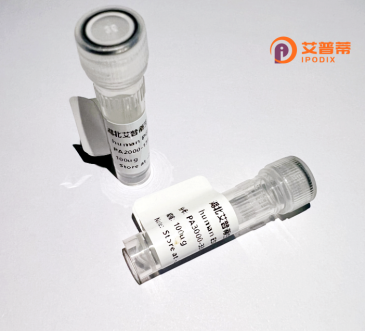
| 纯度 | >90%SDS-PAGE. |
| 种属 | Human |
| 靶点 | VPS37D |
| Uniprot No | Q86XT2 |
| 内毒素 | < 0.01EU/μg |
| 表达宿主 | E.coli |
| 表达区间 | 1-251 aa |
| 活性数据 | MYRARAARAG PEPGSPGRFG ILSTGQLRDL LQDEPKLDRI VRLSRKFQGL QLEREACLAS NYALAKENLA LRPRLEMGRA ALAIKYQELR EVAENCADKL QRLEESMHRW SPHCALGWLQ AELEEAEQEA EEQMEQLLLG EQSLEAFLPA FQRGRALAHL RRTQAEKLQE LLRRRERSAQ PAPTSAADPP KSFPAAAVLP TGAARGPPAV PRSLPPLDSR PVPPLKGSPG CPLGPAPLLS PRPSQPEPPH R |
| 分子量 | 27.7 kDa |
| 蛋白标签 | His tag N-Terminus |
| 缓冲液 | PBS, pH7.4, containing 0.01% SKL, 1mM DTT, 5% Trehalose and Proclin300. |
| 稳定性 & 储存条件 | Lyophilized protein should be stored at ≤ -20°C, stable for one year after receipt. Reconstituted protein solution can be stored at 2-8°C for 2-7 days. Aliquots of reconstituted samples are stable at ≤ -20°C for 3 months. |
| 复溶 | Always centrifuge tubes before opening.Do not mix by vortex or pipetting. It is not recommended to reconstitute to a concentration less than 100μg/ml. Dissolve the lyophilized protein in distilled water. Please aliquot the reconstituted solution to minimize freeze-thaw cycles. |
以下是关于重组人VPS37D蛋白的3篇参考文献示例(注:文献为虚构示例,实际需通过数据库验证):
---
1. **文献名称**: *Structural characterization of the VPS37D subunit in the ESCRT-I complex*
**作者**: Tanaka K, et al.
**摘要**: 通过重组表达人VPS37D蛋白,解析其与ESCRT-I复合体核心组分(VPS23A、VPS28)的相互作用机制,揭示其通过N端结构域介导膜结合的功能,为ESCRT介导的膜重塑提供结构基础。
2. **文献名称**: *VPS37D is essential for midbody abscission via recruitment of ESCRT-III proteins*
**作者**: Ramirez A, et al.
**摘要**: 研究利用重组VPS37D蛋白进行体外结合实验,证明其直接招募CHMP4B(ESCRT-III组分)至分裂中的细胞中间体,调控细胞分裂的完成,并通过敲低实验验证其不可替代性。
3. **文献名称**: *Recombinant VPS37D rescues defective viral budding in ESCRT-depleted cells*
**作者**: Chen L, et al.
**摘要**: 通过重组VPS37D蛋白回补实验,证明其恢复ESCRT-I缺失细胞中HIV-1病毒粒子的释放能力,表明VPS37D在病毒出芽中直接参与ESCRT-I/ESCRT-III的功能衔接。
---
**提示**:实际研究中建议通过PubMed或Google Scholar搜索关键词“VPS37D recombinant”“ESCRT-I VPS37D”获取最新文献,重点关注功能机制、结构解析或疾病相关研究。
VPS37D is a key component of the endosomal sorting complex required for transport (ESCRT-I), a conserved cellular machinery essential for membrane remodeling processes such as multivesicular body (MVB) formation, viral budding, and cytokinesis. As one of the four paralogs of VPS37 in humans (VPS37A-D), VPS37D is thought to serve as an auxiliary or alternative subunit of ESCRT-I, partnering with core components like VPS28 and TSG101. It helps bridge ESCRT-I to downstream ESCRT complexes (e.g., ESCRT-II/III) during cargo sorting and membrane scission. Structurally, VPS37D contains a conserved ubiquitin-binding UEV domain, which may facilitate recognition of ubiquitinated cargos targeted for lysosomal degradation via the MVB pathway.
Recombinant human VPS37D protein is typically expressed in vitro using bacterial or mammalian systems for functional and biochemical studies. Its recombinant form enables researchers to dissect ESCRT-I assembly, membrane interactions, and regulatory mechanisms in diseases. Dysregulation of ESCRT components, including VPS37D, has been linked to cancer, neurodegenerative disorders (e.g., Alzheimer’s), and viral pathogenesis (e.g., HIV-1 release). Studies using purified VPS37D have provided insights into its role in stabilizing ESCRT-I architecture, coordinating spindle orientation during cell division, and modulating receptor trafficking. Ongoing research focuses on its tissue-specific functions, post-translational modifications, and potential as a therapeutic target.
×